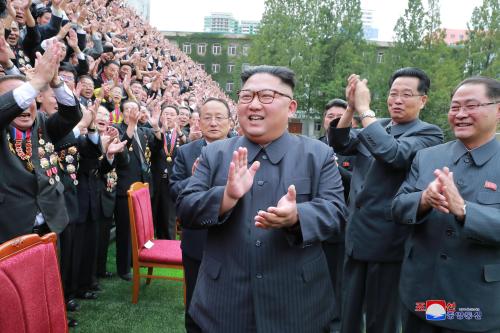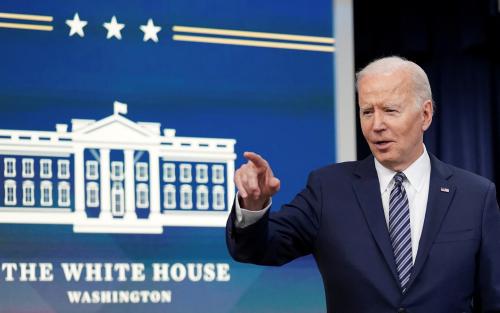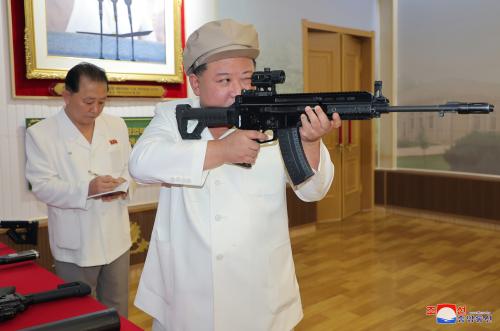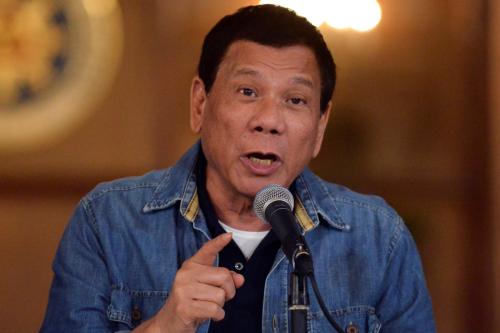This piece originally appeared on the Chicago Council on Global Affairs website and can be found here.
Since the Trump administration took office in January 2017, North Korea has occupied a central place in the administration’s foreign policy. Acting Assistant Secretary of State Susan Thornton said publicly in late April that the administration considers North Korea its “number one national security priority.”1 Although the administration’s response has included a number of components—military signaling and exercises, sanctions, and even presidential tweets—Southeast Asia has quietly but clearly emerged as new focal point of US policy on North Korea.
This piece addresses these developments in three main sections. The first reviews the reasons why the administration might have adopted a more public focus on Southeast Asia’s relations with North Korea, outlining the contours of North Korea’s presence in and engagement with the region. The second section explores the administration’s approach to this presence thus far. The third and final section discusses factors that will shape the future trajectory of relations between North Korea and Southeast Asia, and discusses the implications for future US and international policy toward the Democratic People’s Republic of Korea (DPRK).
North Korea and Southeast Asia: An Under-Explored Connection
How significant are North Korea’s diplomatic and commercial relationships with Southeast Asia? Discussions of China—which is, admittedly, the crucial actor that provides 85-90 percent of North Korea’s trade—have tended to overshadow a small but important set of relationships elsewhere in the Asia Pacific. In fact, North Korea maintains significant relations with Southeast Asia in at least four areas: diplomatic presence, visa-free travel, licit trade volume, and illicit economic and financial activity.
First, North Korea maintains an active diplomatic presence in Southeast Asia. According to data from the East-West Center and National Committee on North Korea, Pyongyang has embassies and diplomatic personnel in at least 10 countries in South and Southeast Asia: Bangladesh, Burma/Myanmar, Cambodia, India, Indonesia, Laos, Malaysia, Singapore, Thailand, and Vietnam.2 This includes all ASEAN member-states except the Philippines and Brunei, and is a noticeable contrast to a number of other regions of the world, where North Korea’s embassy and diplomatic presence have been more limited. In Latin America, for example, less than half the countries of the region host a North Korean embassy. In fact, at the start of 2017, South and Southeast Asia made up over 20 percent of the 47 countries globally where the DPRK maintained an embassy.3 North Korea also remains active in multilateral forums in the region. Like the other participants in the ill-fated Six Party talks on North Korea’s nuclear program, a delegation headed by DPRK Foreign Minister Ri Su-Yong attended the 24th ASEAN Regional Forum in summer 2017, as has occurred since 2000.4
Moreover, a number of countries in South Asia, Southeast Asia, and the Pacific Islands currently offer DPRK nationals visa-free travel. As of early 2017, a total of 39 countries allowed visa-free (or visa-on-arrival) entry to North Koreans, including Bangladesh, Cambodia, Laos, Macau, the Maldives, Micronesia, Nepal, Palau, Samoa, Sri Lanka, and Timor-Leste. Singapore and Malaysia’s visa-free travel arrangements have only been rescinded in the past year (October 2016 and March 2017, respectively).5 As Kent Boydston of the Peterson Institute has noted, there is significant overlap between the countries on the visa-free-travel list and countries that the UN Panel of Experts has identified as sites of illicit activity by the DPRK in violation of UN Resolutions. There is also an overlap between the visa-free list and a cluster of island countries that are known for shell company registration and other opaque financial activity (tax havens, etc).6 This raises the question of whether North Korean actors are using these locations both to export weapons and for arms training—as the Glocom case in Malaysia revealed.7 Additionally, it raises concern that some of these locations may potentially be used to support the flow of illicit funds obtained in these activities for the support of the North Korean regime.
Thirdly, on the trade front, Southeast Asia remains a significant part of the DPRK’s non-China trade profile. Trade with ASEAN (excluding Myanmar, Laos, and Vietnam) stood at $181 million for 2015, and the Philippines alone was North Korea’s third-largest trading partner, with the WTO citing a bilateral trade figure of around $87 million for 2016. (India was between China and the Philippines at $140 million, but has subsequently announced that it would restrict this trade.) Malaysia, where North Koreans came to work in mining, construction, restaurants, and other businesses, talked as late as last year about serving as the “gateway” for North Korean access to Southeast Asia’s markets.8 Interestingly, North Korea runs a consistent trade deficit with Southeast Asia, raising questions about how that imbalance is sustained.9
Beyond formal diplomatic and economic engagement, Southeast Asia has also been a significant site of illicit economic and financial activity, with troubling security repercussions both within the region and beyond. North Korea’s arms export operation through Malaysia has been relatively well-documented, as was the assassination of Kim Jong Un’s half-brother, Kim Jong Nam, in the Kuala Lumpur airport in February 2017. These two high-profile news events helped to bring more attention to North Korea’s general presence in Malaysia and within the region. The DPRK’s presence and engagement in illicit activities stretches beyond Malaysia, however. The Philippines, where North Korean counterfeit currency was first detected in 1989, has been a repeated area of operation for the North Korean drug trade, with multiple methamphetamine-related seizures from 2001-2015. It was also the site of the 2016 interdiction of vessels flying the DPRK flag of convenience in violation of UNSCR 2270, as well as the routing point for disbursement of $81 million stolen from the Bangladeshi Central Bank in last year’s cybertheft attributed to North Korea.10 In March 2016, the United States applied sanctions to the Myanmar military’s procurement organization, the Directorate of Defense Industries, after 2014 satellite imagery showed around 300 North Koreans assisting with the production of surface-to-air missiles.11
According to recent Congressional testimony by John Park, Singapore has also played a key role in allowing North Koreans access to illicit financial service offerings; Singapore-based Chinpo Shipping was also fined in 2016 for facilitating weapons shipments in violation of UN sanctions.12 As is now relatively widely known, there is strong correlation between the DPRK’s official presence and a location’s involvement in illicit operations. Embassies, for example, not only conduct licit diplomatic and economic exchanges, but are also consistently identified in UN reports and other research as sites of illicit procurement and financial transfers by DPRK diplomatic personnel.13
Trump Administration Engagement with Southeast Asia on North Korea
The previously overlooked importance of Southeast Asia for North Korea’s overseas presence and its overseas financial networks explains why it appears to be part of the Trump administration’s larger strategy to increase pressure on Pyongyang. The immediate goals of this strategy appear to be to tighten sanctions enforcement, prevent onward proliferation of DPRK missiles and weapons to other countries of concern (as previously occurred in Syria14), and persuade countries in the region to downgrade or cut off trade ties, including previously licit import and export activity.
While Southeast Asia has been part of previous administrations’ approaches as well—Bush administration officials warned banks in Southeast Asia, among other regions, of the risks of doing business with North Korea in the mid-2000s, and Obama administration officials traveled to Kuala Lumpur in 2009 to discuss troubling arms-related banking activity there—the Trump administration has been relatively more public about its engagement with the region. President Trump has made personal calls to the leaders of Singapore and Thailand, as well as a controversial call to Philippine President Rodrigo Duterte.15 Secretary of State Rex Tillerson prioritized North Korea in his first meeting with the 10 ASEAN foreign ministers in Washington earlier this year,16 and visited Thailand and Malaysia after the ASEAN Regional Forum in the Philippines in an effort to persuade countries in the region to downgrade diplomatic and economic ties.17 In July, special envoy Joseph Yun made a trip to Myanmar, presumably to follow up on the sanctions imposed in March for activities related to DPRK weapons programs and to discuss the administration’s efforts to persuade Naypyidaw to downgrade or sever its links with Pyongyang.18
These efforts—combined with North Korea’s extended period of intensive nuclear and missile testing from 2016 into 2017—appear to be producing some response among regional actors as well as globally.19 Although ASEAN has not excluded North Korea altogether from the regional forum, the organization issued a statement in August that strongly criticized DPRK missile testing and other security behavior for its negative impact on regional peace and stability.20 Malaysia terminated its visa-free travel arrangement for DPRK citizens earlier this year and in late September banned travel by its own citizens to North Korea, a significant step for the only country whose nationals were allowed visa-free travel to the DPRK.21 India, the Philippines, and Singapore have all announced during 2017 that they would decrease trade,22 and the involvement of an Indonesia national in the assassination operation in Kuala Lumpur appears to have provoked some economic backlash in Indonesia against North Korea as well.23
Implications for the Region
What is the likely future trajectory and impact of North Korea’s engagement with and presence in Southeast Asia? Developments in Southeast Asia are likely to interact with two other major factors to shape events in the future.
The first development is that, in seeking to increase pressure on North Korea, the United States has shifted focus from pressuring only DPRK economic activity that is clearly illicit and/or weapons-related to a broader clampdown on all DPRK economic activities worldwide—the most recent UN Resolution, Resolution 2375, included a textile export ban and shifted the international community’s policies towards the DPRK in that direction as well. Both the North Korea Sanctions Policy Enhancement Act passed in 2016 by Congress24 and the administration’s most recent Executive Order25 broadened sanctions authority to allow the United States to designate any individuals, companies, or financial institutions doing business with North Korea, not just those engaged in supporting its weapons-related activities. Combined with the recent naming of additional North Korean entities and individuals (eight banks and 26 individuals in the most recent round of designations announced in September 2017), these measures appear to be designed to force China, as well as countries in Southeast Asia and elsewhere, to choose between supporting North Korea economically and doing business with the United States.
Second, China’s posture toward the DPRK appears to be evolving. Although analysts have raised concerns about the credibility of the administration’s threat to place secondary sanctions on Chinese banks, given the intertwining of the American and Chinese economies and the large financial presence of some of the banks mentioned inside the United States, China’s posture appears to be shifting. In late September 2017, China’s commerce ministry announced that it had directed North Korean companies operating in China (as well as Chinese-North Korean joint ventures operating in North Korea) to shut down in the next 120 days.26 There are exemptions—Chinese companies inside the DPRK are still allowed to function, the existing closures do not apply to all “nonprofit and noncommercial public infrastructure projects,” and the order may not encompass some of the actors involved in facilitating sanctions evasion—but the move is a shift away from past Chinese insistence that the DPRK be allowed to continue “legitimate trade” and that sanctions only apply narrowly to weapons-related activities and actors. Acceptance of this principle by the Chinese government and/or Chinese commercial and financial actors would be a significant shift in the China’s position, even if it is never explicitly stated.
The evolving stances of both the US and China are likely to increase Southeast Asian countries’ willingness to sever diplomatic and/or trade ties with North Korea. Countries in the region have been traditionally reluctant to adopt an interventionist stance against their neighbors, particularly if there is not a regional consensus and as long as China—the largest trade partner of many in the region—is opposed. Beijing’s behavior may indicate to others that this regional consensus is shifting, especially if the US and China are aligned. A shift in Southeast Asia’s thinking could be significant when paired with Chinese restrictions. Under circumstances where the China connection is pressured, North Korea is likely to seek alternative partners—licit and otherwise—and to attempt to shift financial networks to adapt around sanctions, as it has consistently done in the past.27 For sanctions to affect DPRK behavior and decision-making in any significant way, it will be important that North Korea not be able to leverage existing ties in South Asia, Southeast Asia, and the Asia-Pacific to replace what is being constricted by Beijing.
Enforcement will be critical, and remains problematic. As of early 2017, 116 of the 193 countries bound by UN Resolutions on North Korea had yet to submit a single implementation report. In Southeast Asia, these countries included Bangladesh, Brunei, Cambodia, India, Indonesia, Maldives, Myanmar, Sri Lanka, Thailand, Timor-Leste, Micronesia, Papua New Guinea, and a number of the small island nations in the Asia-Pacific where North Koreans can travel visa-free.28 The evolution of American and Chinese stances on North Korea are likely to shape these countries’ level of interest in sanctions enforcement, but some support for increasing their capacity is likely to be necessary for enforcement to go from its current state to its full potential.
Nonparticipation by China and Southeast Asia—along with lax enforcement worldwide and the capacity of the North Korean regime to shift the costs of economic punishment from regime elites to citizens wherever possible—are possible reasons why the sanctions regime appeared to have relatively little impact on North Korea’s economy through the end of last year. The enhanced participation of China and Southeast Asia in 2017 could change that calculus, especially if enforcement is tightened as well—meaning that North Korea may well feel increased pressure in the coming months. The question then is what amount of increased pressure, if any, is sufficient to make North Korea change course. The answer to that question is far from clear, but this administration appears to be raising the stakes in an effort to find out. For that reason, the stakes in—and for—Southeast Asia are higher than they have been in a long time.
The views represented in this paper are those of the author and do not necessarily represent the views of the Chicago Council on Global Affairs. This paper was made possible by the generous support of the Consulate General of Japan in Chicago.
-
Footnotes
- Susan Thornton, “North Korea’s Imminent and Long-term Threats: Good, Bad, and Worse Options,” Remarks at Foundation for Defense of Democracies, April 27, 2017.
- “DPRK Embassies Worldwide,” North Korea in the World
- Since the start of the year, at least five countries that hosted embassies – but none of them in Southeast Asia – have expelled DPRK ambassadors: Italy, Kuwait, Mexico, Peru, and Spain.
- Prashanth Parameswaran, “Why Was a North Korean Official in the Philippines Before the ASEAN Regional Forum,” The Diplomat, July 27, 2017.
- “North Koreans Traveling to Singapore Will Require Visas from Oct 1,” The Straits Times, July 30, 2016.
- Stephen Haggard and Kent Boydston, “North Korea and the 2017 Passport Index,” Peterson Institute for International Economics, March 23, 2017.
- James Pearson, “North Korea Spy Agency Runs Arms Operation out of Malaysia, UN Says,” Reuters, February 26, 2017.
- Tom Allard, A. Ananthalakshmi, “Once Strong Ties between North Korea and Malaysia Rapidly Unravel,” Reuters, March 7, 2017.
- Kent Boydston, “North Korea and the Southeast Asia Connection,” Peterson Institute for International Economics, May 26, 2017.
- Sheena Chestnut Greitens, “Can Trump Count on Manila to Put Pressure on North Korea? 3 Points to Know,” The Washington Post, May 16, 2017.
- Catherine Dill, Jeffery Lewis, “Suspect Defense Facility in Myanmar,” James Martin Center for Nonproliferation Studies, May 9, 2014.
- John Park, “Restricting North Korea’s Access to Finance,” Statement before the House Committee on Financial Services Subcommittee on Monetary Policy and Trade, July 19, 2017; see also Fathin Ungku, “Singapore slaps S$180,000 fine on North Korea-linked shipper,” Reuters, January 29, 2016.
- Ibid; see also: Sheena Chestnut, “Illicit Activity and Proliferation,” International Security, Vol. 32, No. 1 pp. 80-111.
- David Makovsky, “The Silent Strike, How Israel bombed a Syrian nuclear installation and kept it a secret,” The New Yorker, September 2017.
- Transcript of Phone Call between Donald Trump and Rodrigo Duterte, Department of Foreign Affairs, Republic of the Philippines, No. OAA-919-MASA-2017, Republic of the Philippines.
- Prashanth Parameswaran, “What Was the First Special US-ASEAN Meeting Under Trump Really About,” The Diplomat, May 13, 2017.
- Jake Maxwell Watts, Ben Otto, “Tillerson Presses Asian Nations to Clamp Down on North Korea,” The Wall Street Journal, August 8, 2017.
- Simon Lewis, “Myanmar Insists No North Korea Links as US Envoy Visits,” Reuters, July 17, 2017.
- Paul Sonne, Felicia Schwartz, “US Pressure on North Korea’s Global Ties Bears Fruit,” The Wall Street Journal, October 8, 2017.
- Associated Press, “Southeast Asia issues strong rebuke, warning to North Korea,” Politico, August 5, 2017.
- Prashanth Parameswaran, “What’s Behind Malaysia’s New North Korea Travel Ban,” The Diplomat, September 29, 2017.
- Ivana Kottasova, “North Korea Cut off by 3rd Biggest Trading Partner,” CNN Money, May 1, 2017. See also: “Philippines Suspends Trade with North Korea to Comply with US Resolution,” Reuters, September 8, 2017; “Singapore Suspends Trade Relations with North Korea,” Reuters, November 16, 2017.
- Jun Suzuki, Tomomi Kikuchi, “Southeast Asia Clamping down on North Korean Businesses,” Nikkei Asian Review, March 30, 2017.
- US Congress, North Korea Sanctions and Policy Enhancement Act of 2016, Public Law 114-122 (Washington, DC, 2016).
- Executive Order No. 13810, 3 C.F.R. 44705 (2017)
- Charles Clover, Bryan Harris, and Hudson Lockett, “North Korean Companies in China Ordered to Close,” Financial Times, September 28, 2017.
- Sheena Chestnut Greitens, “ILLICIT, North Korea’s Evolving Operations to Earn Hard Currency,” Committee for Human Rights in North Korea, 2014.
- Ben Kesling, Alastair Gale, “Trump’s North Korea Obstacle: Sanctions Are Unevenly Enforced,” The Wall Street Journal, April 25, 2017.









Commentary
North Korea’s activities in Southeast Asia and the implications for the region
November 29, 2017